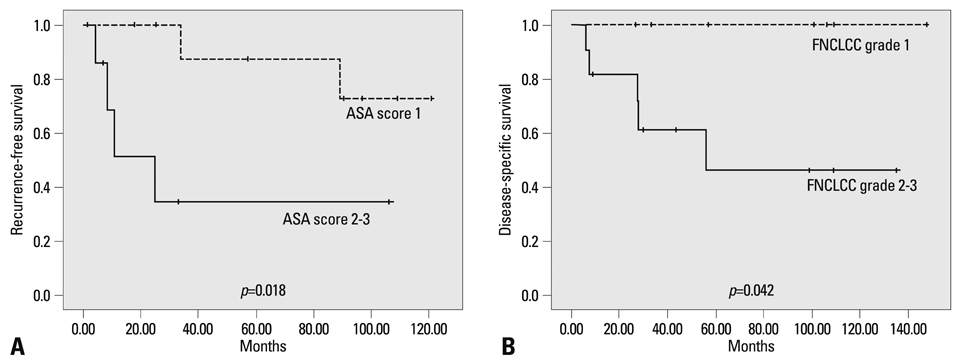Yonsei Med J.
2011 Sep;52(5):761-767. 10.3349/ymj.2011.52.5.761.
Localized Resectable Genitourinary Sarcoma in Adult Korean Patients: Experiences at a Single Center
- Affiliations
-
- 1Department of Urology, Seoul National University Hospital, Seoul, Korea. kuuro70@snu.ac.kr
- 2Department of Pathology, Seoul National University Hospital, Seoul, Korea.
- KMID: 1108068
- DOI: http://doi.org/10.3349/ymj.2011.52.5.761
Abstract
- PURPOSE
To evaluate the clinicopathological characteristics and prognosis of localized resectable genitourinary sarcomas in adults.
MATERIALS AND METHODS
Between September, 1996 and November, 2008, 18 consecutive cases of adults (12 men and 6 women; median age 48.8 years) who were treated for primary genitourinary sarcomas were identified. The following variables were analyzed: patient age, gender, body mass index, American Society of Anesthesiologists (ASA) score, primary organ, tumor histology, size, necrosis, Federation Nationale des Centres de Lutte Contre le Cancer (FNCLCC) grade, and surgical margin positivity. Recurrence-free survival and disease-specific survival were the study end-points.
RESULTS
The most common presenting symptom was a palpable mass (six cases, 33.3%), the most common site was the kidney (six cases, 33.3%), and the most common histological subtype was leiomyosarcoma (eight patients, 44.4%). Complete resection with negative surgical margins was achieved in 13 patients (72.2%). The median follow-up period was 49.9 months (range 6.4 to 147.6). The recurrence-free survival rates at 1, 3, and 5 years were 81.6%, 66.5%, and 66.5%, respectively. Recurrence-free survival only associated significantly with ASA score (p=0.018). The disease-specific survival rate at 1, 3, and 5 years was 88.9%, 76.2%, and 67.7%, respectively. Disease-specific survival was associated significantly only with FNCLCC grade (p=0.042).
CONCLUSION
Although genitourinary sarcomas in adults are a rare group of tumors with a poor prognosis, some patients may have a favorable prognosis. Our findings suggest that FNCLCC grade is the most important prognostic factor for these patients.
Keyword
MeSH Terms
Figure
Reference
-
1. Hayes AJ, Thomas JM. Soft tissue tumours. Postgrad Med J. 1997. 73:705–709.
Article2. Russo P, Brady MS, Conlon K, Hajdu SI, Fair WR, Herr HW, et al. Adult urological sarcoma. J Urol. 1992. 147:1032–1036.
Article3. Stojadinovic A, Leung DH, Allen P, Lewis JJ, Jaques DP, Brennan MF. Primary adult soft tissue sarcoma: time-dependent influence of prognostic variables. J Clin Oncol. 2002. 20:4344–4352.
Article4. Mondaini N, Palli D, Saieva C, Nesi G, Franchi A, Ponchietti R, et al. Clinical characteristics and overall survival in genitourinary sarcomas treated with curative intent: a multicenter study. Eur Urol. 2005. 47:468–473.
Article5. Dotan ZA, Tal R, Golijanin D, Snyder ME, Antonescu C, Brennan MF, et al. Adult genitourinary sarcoma: the 25-year Memorial Sloan-Kettering experience. J Urol. 2006. 176:2033–2038.
Article6. Coindre JM, Terrier P, Bui NB, Bonichon F, Collin F, Le Doussal V, et al. Prognostic factors in adult patients with locally controlled soft tissue sarcoma. A study of 546 patients from the French Federation of Cancer Centers Sarcoma Group. J Clin Oncol. 1996. 14:869–877.
Article7. Harrell FE Jr, Lee KL, Matchar DB, Reichert TA. Regression models for prognostic prediction: advantages, problems, and suggested solutions. Cancer Treat Rep. 1985. 69:1071–1077.8. Murphy WM, Beckwith JB, Furrow GM. Rosai J, Sobin LH, editors. Tumors of the kidney. Atlas of Tumor Pathology: Tumors of the Kidney, Bladder, and Related Urinary Structures. 1994. 3rd ed. Washington DC: Armed Forces Institute of Pathology;158–161.9. Beccia DJ, Elkort RJ, Krane RJ. Adjuvant chemotherapy in renal leiomyosarcoma. Urology. 1979. 13:652–654.
Article10. Srinivas V, Sogani PC, Hajdu SI, Whitmore WF Jr. Sarcomas of the kidney. J Urol. 1984. 132:13–16.
Article11. Kuroda N, Sakaida N, Kinoshita H, Matsuda T, Hes O, Michal M, et al. Carcinosarcoma arising in mixed epithelial and stromal tumor of the kidney. APMIS. 2008. 116:1013–1015.
Article12. Kren L, Goncharuk VN, Votava M, Hermanová M, Ross JS, Nazeer T, et al. Botryoid-type of embryonal rhabdomyosarcoma of renal pelvis in an adult. A case report and review of the literature. Cesk Patol. 2003. 39:31–35.13. Tsai WC, Lee SS, Cheng MF, Lee HS. Botryoid-type pleomorphic rhabdomyosarcoma of the renal pelvis in an adult. A rare case report and review of the literature. Urol Int. 2006. 77:89–91.
Article14. Lv C, Chen N, Zhu X, Zhang X, Zhong Z. Primary leiomyosarcoma of the ureter. Asian J Surg. 2008. 31:191–194.
Article15. Parekh DJ, Jung C, O'Conner J, Dutta S, Smith ER Jr. Leiomyosarcoma in urinary bladder after cyclophosphamide therapy for retinoblastoma and review of bladder sarcomas. Urology. 2002. 60:164.
Article16. Spiess PE, Kassouf W, Steinberg JR, Tuziak T, Hernandez M, Tibbs RF, et al. Review of the M.D. Anderson experience in the treatment of bladder sarcoma. Urol Oncol. 2007. 25:38–45.
Article17. Rosser CJ, Slaton JW, Izawa JI, Levy LB, Dinney CP. Clinical presentation and outcome of high-grade urinary bladder leiomyosarcoma in adults. Urology. 2003. 61:1151–1155.
Article18. Russo P, Brady MS, Conlon K, Hajdu SI, Fair WR, Herr HW, et al. Adult urological sarcoma. J Urol. 1992. 147:1032–1036.
Article19. Strander H, Turesson I, Cavallin-Ståhl E. A systematic overview of radiation therapy effects in soft tissue sarcomas. Acta Oncol. 2003. 42:516–531.
Article20. Sexton WJ, Lance RE, Reyes AO, Pisters PW, Tu SM, Pisters LL. Adult prostate sarcoma: the M.D. Anderson Cancer Center Experience. J Urol. 2001. 166:521–525.21. Fisher C, Goldblum JR, Epstein JI, Montgomery E. Leiomyosarcoma of the paratesticular region: a clinicopathologic study. Am J Surg Pathol. 2001. 25:1143–1149.22. Montgomery E, Fisher C. Paratesticular liposarcoma: a clinicopathologic study. Am J Surg Pathol. 2003. 27:40–47.23. Stojadinovic A, Leung DH, Hoos A, Jaques DP, Lewis JJ, Brennan MF. A nalysis of the prognostic significance of microscopic margins in 2,084 localized primary adult soft tissue sarcomas. Ann Surg. 2002. 235:424–434.
Article24. Froehner M, Lossnitzer A, Manseck A, Koch R, Noack B, Wirth MP. Favorable long-term outcome in adult genitourinary low-grade sarcoma. Urology. 2000. 56:373–377.
Article25. Italiano A, Delva F, Mathoulin-Pelissier S, Le Cesne A, Bonvalot S, Terrier P, et al. Effect of adjuvant chemotherapy on survival in FNCLCC grade 3 soft tissue sarcomas: a multivariate analysis of the French Sarcoma Group Database. Ann Oncol. 2010. 21:2436–2441.
Article


